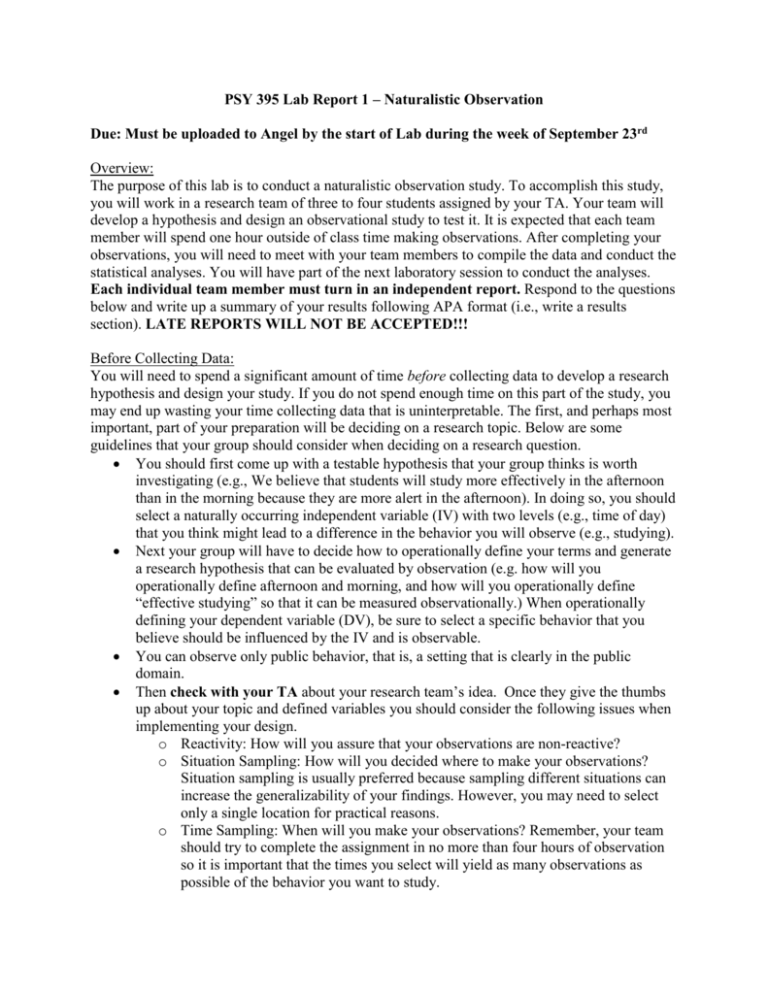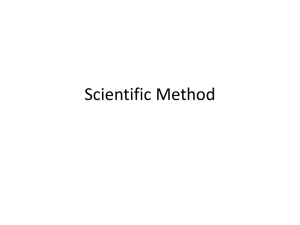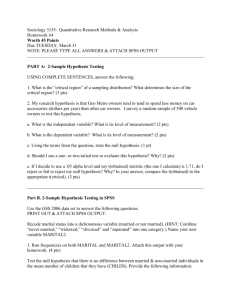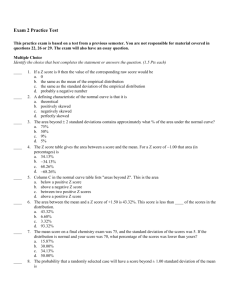Lab Report 1
advertisement

PSY 395 Lab Report 1 – Naturalistic Observation Due: Must be uploaded to Angel by the start of Lab during the week of September 23rd Overview: The purpose of this lab is to conduct a naturalistic observation study. To accomplish this study, you will work in a research team of three to four students assigned by your TA. Your team will develop a hypothesis and design an observational study to test it. It is expected that each team member will spend one hour outside of class time making observations. After completing your observations, you will need to meet with your team members to compile the data and conduct the statistical analyses. You will have part of the next laboratory session to conduct the analyses. Each individual team member must turn in an independent report. Respond to the questions below and write up a summary of your results following APA format (i.e., write a results section). LATE REPORTS WILL NOT BE ACCEPTED!!! Before Collecting Data: You will need to spend a significant amount of time before collecting data to develop a research hypothesis and design your study. If you do not spend enough time on this part of the study, you may end up wasting your time collecting data that is uninterpretable. The first, and perhaps most important, part of your preparation will be deciding on a research topic. Below are some guidelines that your group should consider when deciding on a research question. You should first come up with a testable hypothesis that your group thinks is worth investigating (e.g., We believe that students will study more effectively in the afternoon than in the morning because they are more alert in the afternoon). In doing so, you should select a naturally occurring independent variable (IV) with two levels (e.g., time of day) that you think might lead to a difference in the behavior you will observe (e.g., studying). Next your group will have to decide how to operationally define your terms and generate a research hypothesis that can be evaluated by observation (e.g. how will you operationally define afternoon and morning, and how will you operationally define “effective studying” so that it can be measured observationally.) When operationally defining your dependent variable (DV), be sure to select a specific behavior that you believe should be influenced by the IV and is observable. You can observe only public behavior, that is, a setting that is clearly in the public domain. Then check with your TA about your research team’s idea. Once they give the thumbs up about your topic and defined variables you should consider the following issues when implementing your design. o Reactivity: How will you assure that your observations are non-reactive? o Situation Sampling: How will you decided where to make your observations? Situation sampling is usually preferred because sampling different situations can increase the generalizability of your findings. However, you may need to select only a single location for practical reasons. o Time Sampling: When will you make your observations? Remember, your team should try to complete the assignment in no more than four hours of observation so it is important that the times you select will yield as many observations as possible of the behavior you want to study. o Participant Sampling: How will you select those whom you will observe? If you are observing in a setting in which there are more people eligible for your study than you can tally at once, how will you decide whom to include? o Data Reduction: Before beginning your observations, decide what kind of DV you are using (e.g., frequency, duration, ratings) and ask yourself how you will be able to summarize your results (e.g., what statistical tests you will use). o Reliability: Before beginning your observations, decide what factors in your study lead you to believe your observations will be reliable. You will need to obtain reliability with another member of your team on a least a portion of observations (10-25%). How will you calculate reliability? Collecting Data: Each student in your team should spend at least 1 hour outside of class making observations. Since this is an observational study and observations can be very subjective, for some portion of your observations, you and another team member (or, more!) should observe the same situation at the same time and record the same behavior. This should be done independently (don’t code together – this defeats the purpose). So, for example, if you are looking at studying behavior in the library, two team members should observe at the same time from different sides of the room to determine if you are both observing the same behavior. Then you will report the interobserver reliability. Analyzing Your Data: You will combine your data with your team members’ data. You should reduce your data using the appropriate descriptive statistics. I also recommend graphing your data or putting it into tables first to get a good idea of what it looks like. Finally, you should analyze your data using the appropriate statistical test. After you do this, you will want to interpret your data. It is not expected that you will achieve a clearly interpretable, significant result. However, this step should help you see how this process works and give you an idea of what would need to be done differently in the future (e.g., more observations, etc.). Brief Lab Report For the lab report please answer the following questions. Use a short answer format, numbering your responses accordingly. You will complete a lab report based on this project. The lab report is worth 50 points. Please type up your answers and clearly identify the question you are answering by numbering your responses. Unless otherwise noted, you should be able to answer each question with approximately 1 to 4 sentences, in some cases a paragraph. Each student needs to turn in a separate report. 1. In the Schachter et al. (1991) article: a. (1 pt) What was the research question? b. (1 pt) What was the research hypothesis? 2. In the Ruback and Juieng (1997) article: a. (1 pt) What was the research question? b. (1 pt) What was the research hypothesis of study 1? 3. (3 pts) What research question were you trying to answer by doing your observation project and why was this question important to you? 4. (3 pts) What was your research hypothesis? What was the reason underlying your hypothesis? 5. (3 pts) What was the operational definition of the naturally occurring IV in your project? What operational definition did you use for the DV in your project? 6. (2 pts) How did you avoid intervening in the situation you were observing so as to avoid reactivity? 7. (3 pts) What specific procedures did you use for time sampling, situation sampling, and participant sampling? 8. (3 pts) Describe the conclusions you would draw on the basis of the results of your study. 9. (4 pts) Identify at least 2 weaknesses of your study. Describe what type of follow-up study would be needed to better support your hypothesis. Results Section (25 pts): I would like you to get experience presenting your findings in APA format. Therefore, this section should be written formally and be consistent with APA style. For the purpose of this lab assignment, please start the results section on a separate page. It should be 1 or 2 paragraphs. This section will be graded on the clarity of your writing and presentation of your tables/figures and on your use of APA style. Please see p. 506 - 514 of your book for information on the format of the different sections of a paper. Your written results section should have the following items: 1. State the purpose of the analysis. 2. Identify the descriptive statistic to be used to summarize results. 3. In your result section, you should mention your reliability (Interobserver agreement). For this assignment, estimate the reliability using the percentage of agreements, agreements/ (agreements + disagreements) X 100. Then average across different estimates. a. If your study requires you to count the frequency (or some other measure) of an observed behavior then an alternative measure of reliability is the percentage difference in counts, smaller#/larger X 100. For example, if observer 1 counts 30 cappuccinos and observer 2 counts 35 then there was 86% overlap in the counts (30/35 x 100). Report the average reliability across the different group members. 4. Present a summary of the descriptive statistics across conditions in the text itself. Use the appropriate descriptive statistics given the nature of your DV. 5. Present the inferential statistics that are relevant for answering your research question. Make sure you report the statistical test you used and include the statistical results in text. a. Here is an example of how to write up the results of a t-test: More studying was observed in the morning hours (M = 2.3, SD = 0.8) than in the afternoon hours (M = 1.2, SD = 0.4; t(19) = 3.18, p < .05). 6. State the conclusion that follows from each test, but do not discuss implications. The results section should provide enough information to your reader to understand the results of the study, but does not include an interpretation of the results.









